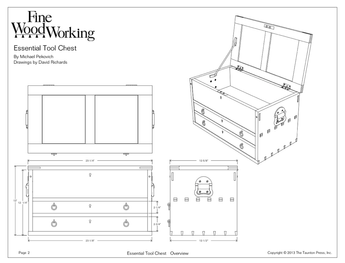I’m converting a small (11 x 14 foot) out building into a wood shop. It has concrete floors and walls of unfinished gypsum board. It also has two three-foot wide French doors (they’re double-paned glass panels in a wood frame). The problem is the doors open into the shop; I’d like them to open outward. Can I accomplish this by removing the casing, jamb, and threshold, then reversing the jamb and threshold? One problem is the door hinges will be on the outside. Will this allow someone to easily break into the shop by removing the hinge pins? How can I solve this problem?
Robert in Albuquerque















Replies
If you fix the hinges what's going to stop them from breaking out the glass?
Good point, I thought of that. I plan to use a deadbolt which requires a key on both sides to open. I live in a quiet neighborhood and my two next door neighbors are retired, so they're often at home during the day. I should probably not worry too much about theft. I just want to make it difficult for someone to get into the shop without a key.
Robert in Albuquerque
Yes, you can do that. It isn't quite trivial, but it is possible.
You'll probably have to do a little fiddling with the threshold. Exterior doors are generally not hung in the middle of the jamb, but rather toward the interior (when the door opens in). The hump in the typical threshold is intended to be underneath the door (when the door opens in). When you reverse the jamb, the door and the threshold may no longer line up. But you're a woodworker -- if all else fails you can build your own threshold.
You should put trim or a drip cap just above the out-swinging doors. In-swinging exterior doors have inherent protection against precipitation blowing or dripping in the top of the door, but an outswing doesn't.
Hinges do exist with fixed pins. They make hanging the door a wrestling match, but they do exist. The break-the-glass argument would be enough to make me just use conventional hinges.
Jamie,
Thanks for the advice. I was poking around some door manufacturer's web-pages. They have drawings which show the profile for thresholds for outswing doors. It should not be too much trouble to produce the right threshold. They also give detatiled intsructions on how to install outsiwing doors.
The drip cap is a good idea; it does not rain much here in Albuquerque, but when it rains, it pours. The rake edge of the roof overhangs the door about 1 foot, so it does not offer much protection from the elements.
Robert in Albuquerque
Robert... There are 'fixed pin' hinges where the pin is permanently locked in place and there are also hinges where the pin is held in place with a 'hidden' set screw. You will have to look around but it is available. Seal the top of the door with several coats of oil based paint to protect the door from any water that gets onto the top of the door. A drip cap above the door frame will help. If you have the clearance, make a cap to cover the top of the door. THIN aluminum flashing or even aluminum plates from the local printer are great for this application. It has to cover (seal) the top edge of the door and come down all four sides for only 1/2".
SawdustSteve
There are available loose-pin hinges which have "dimples" punched into the leaves to prevent door removal. I know about them cause they're on appropriate doors in my home (there when we bought it), but I don't know where to buy them.
Shel
Steve,
Thank you for the help. I'll see if I can find the fixed pin hinges. I'll also include a drip edge and try to seal the top of the door. How would you attach the aluminum to the top of the door? Construction adhesive?
Robert in Albuquerque
Robert... I use a few dabs of silicon caulking in the corners to seal the aluminum cap and then secure the whole thing with a few staples along each long edge just to make sure the cap doesn't ride up. A good commercial hardware store should be have the hinges you need. (Home Despot and Louie's most likely will not even know about these hinges.) Sometimes a locksmith that does a lot of commercial work will know of a source.
SawdustSteve
Thanks Steve. I think I have all the materials on hand to try reversing the doors this weekend.
Robert in Albuquerque
Most hinges that I've seen are 'swaged' such that the hinge barrel is to the inside edge of the edge of the door that it's attached to. So in effect, the door cannot be simply swung out from the hinge once the pin has been removed. The door has to be open slightly to allow it to be pulled away from the jamb and clear the hinge barrel. Take a look at the geometry of your hinges and it should be clear what I'm trying to describe.
Leave the glass! Every bit of natural light is an asset. Just go to the hardware store, buy some 1/4" hardware cloth (like what one would use to make a rabbit hutch) and fasten it to the inside of the door lites. Mill a piece of finished wood to fit over the raw edges and you've got a nice, secure door.
Dennis in Bellevue WA
woodnut@anatechsys.com
BINGO! Dennis, You hit the nail on the head. Just take a regular loose pin 'Butt' hinge in your hand .Remove the pin and while keeping the two leafs in the closed position, try to pull the leafs apart. Then open them a bit and try some more . It would have to positioned about 15 degrees open to slip free.
If you have to pry the door open 15 degrees to accomplish that feat, you could throw a dead cat through the space without bumping either side.
I, simply screw a 1/2" 'lag' screw into the door below the top hinge and one above the bottom hinge then cut the heads off. Bore out holes in the jamb to receive those 'suckers' Note: Do this, one screw and hole at a time, Stein
Robert, if your concerned about people looking in get some blinds, or better yet, replace the glass panes with plexiglass aswell, if it's possible. As long as you don't make it look flashy to attract attention, chances are no one will try to find out what's inside.
Great idea. I'll keep the glass doors and install some blinds. I'll have to get some of those accordion blinds that ride in metal tracks. They'll be easy to keep clean and they do not have chords to get tangled every time I open the doors. Thanks for the idea.
R J, just leave the jamb alone. Remove the doors and 'stops'
Mark out where the hinges will go and screw them to the jamb.The doors will then swing out ,though ,they will strike each other. .
The solution to this is 'Double cutting'. Remove one door at a time and remove the hinge leafs. With a hammer and sharp chisel chop out the hinge's 'Gain' the extra amount equivilent to the hinge's thickness.
Reinstall the hinges and put the doors back Voila! YIB (You're in business) Stein.
Drip cap is needed as well as one attached across the bottom to deflect water away from the sill. French doors are notorious water absorbers due to all those mullions and muntins, so caulk with 100 percent silicone made by G E.G,Luck Use my idea about lag screws.
Oh,yeah, put back the stops.
Edited 6/7/2003 9:31:12 PM ET by steinmetz
When you put the hinges back, leave one screw out on each side of the hinge. Put a nail with the head cut off in the screw hole. Drive it in far enough that it seats good and that the door will close. This creates a long pin that will keep the door in place even if someone should remove the hinge pin.
This forum post is now archived. Commenting has been disabled